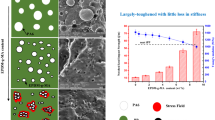Abstract
The effects of phase morphology, interfacial adhesion and filler particle shape and volume fraction on the fracture toughness of polypropylene (PP) filled with CaCO3 or Mg(OH)2 and ethylene-propylene elastomer (EPR) were investigated. Separation of the inorganic filler and elastomer particles was achieved using maleic-anhydride-grafted PP (MPP) to enhance the inorganic filler-matrix adhesion. Encapsulation of the rigid filler by the elastomer was achieved by using maleic-anhydride-grafted EPR (MEPR) to increase the inorganic filler-elastomer adhesion. The two limiting morphologies differed significantly in fracture toughness under impact loading at the same material composition. A model for a mixed mode of failure, accounting for the plane strain and plane stress contributions to the strain energy release rate,G c, was used to predict the upper and lower limits forG c for the two limiting morphologies over an interval of elastomer volume fractions,v e, from 0–0.2 at a constant filler volume fraction,V f = 0.3, and over the filler volume fraction from 0–0.4 at constant EPR content. The role of material yield strength in controlling fracture toughness has been described successfully using Irwin's analysis of plastic zone size. The presence of elastomer enhances both the critical strain energy release rate for crack initiation,G c, and the resistance to crack propagation as expressed by Charpy notched impact strength for the two limiting morphologies. Satisfactory agreement was found between the experimental data and predictions of upper and lowerG c limits.
Similar content being viewed by others
References
J. M. Hodgkinson, A. Savadori andJ. G. Williams,J. Mater. Sci. 18 (1983) 2319.
P. L. Fernando andJ. G. Williams,Polym. Eng. Sci. 20 (1980)215.
S. Wu,Polymer 26 (1985) 1855.
Idem, J. Appl Polym. Sci. 35 (1988) 549.
R. J. M. Borggreve,Polymer 28 (1987) 1489.
R. J. M. Borggreve, R. J. Gaymans andA. R. Luttmer,Makromol. Chem. Macromol Symp. 16 (1988) 195.
B. Z. Jang, D. R. Uhlmann andJ. B. Vander Sande,J. Appl. Polym. Sci. 29 (1984) 3409.
Idem, ibid. 29 (1984) 4377.
Idem, ibid. 30 (1985) 2485.
J. Jancar, A. DiAnselmo andA. T. DiBenedetto,Polym. Eng. Sci. 33 (1993) 559.
J. Jancar, A. Dianselmo, A. T. Dibenedetto andJ. Kucera,J. Polymer 34 (1993) 1684.
J. Kolarik, F. Lednicky, J. Jancar andB. Pukanszky,Polym. Commun. 30 (1991) 201.
J. Kolarik, F. Lednicky andB. Pukanszky, in “Proceedings of the 6th International Conference on Composite Materials” Edited by F. L. Mathews, N. C. R. Bushell, J. M. Hodgkinson and J. Mordon. (Elsevier, London, 1987) p. 452.
W. -Y. Chiang, W. -D. Yang andB. Pukanszky,Polym. Eng. Sci. 32 (1992) 641.
J. Jancar andA. T. DiBenedetto, in “Proceedings of the 51st ANTEC SPE”, Brookfield New Orleans, 9–12 May 1993, p. 1698
Idem, in “Proceedings of the 24th IUPAC Symposium on Macromolecules”, Prague, 12–18 July 1993 (VSP Publishers) p. 399.
Idem, J. Mater. Sci. 28 (1993) 0000.
F. A. McClintock andG. R. Irwin, “Fracture Toughness Testing” (ASM, Philadelphia 1965) p. 85.
J. Williams, “Fracture Mechanics of Polymers” (Ellis Horwood, Chichester, 1983) p. 100.
A. J. Kinlock andR. J. Young, “Fracture Behavior of Polymers” (Elsevier, London, 1983) Ch. 6, p. 182.
M. Parvin andJ. G. Williams,J. Mater. Sci. 10 (1975) 1883.
Idem, Int. J. Fract. 11 (1975) 963.
R. A. Fraser andI. M. Ward,Polymer 19 (1978) 220.
G. L. Pitman andI. M. Ward,ibid. 20 (1979) 895.
P. J. Hine, R. A. Duckett andI. M. Ward,ibid. 22 (1981) 1745.
L. E. Nielsen, “Mechanical Properties of Polymers and Composites”, Vol 11 (Dekker New York, 1974) p. 387.
J. Jancar, A. DiAnselmo andA. T. DiBenedetto,Polym. Eng. Sci. 32 (1992) 1394.
L. Nicolais andM. Narkis,ibid. 11 (1971) 194.
Author information
Authors and Affiliations
Rights and permissions
About this article
Cite this article
Jancar, J., Dibenedetto, A.T. Failure mechanics in ternary composites of polypropylene with inorganic fillers and elastomer inclusions. J Mater Sci 30, 2438–2445 (1995). https://doi.org/10.1007/BF01184598
Received:
Accepted:
Issue Date:
DOI: https://doi.org/10.1007/BF01184598




